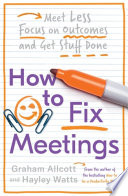

One of the core tenets of 'How to Fix Meetings' is the necessity to redefine the purpose of meetings. Traditionally, meetings are often viewed as obligatory gatherings without clear objectives, leading to wasted time and disengagement. The book argues that every meeting should have a distinct purpose that aligns with the organization’s goals. This means that before scheduling a meeting, organizers should ask themselves what outcomes they expect and how these outcomes contribute to larger objectives. By establishing a clear purpose, participants can come prepared, ensuring that discussions are focused and productive. The book emphasizes that this shift in mindset can transform meetings from being a chore into a strategic tool for collaboration and decision-making.
Continue readingPreparation is highlighted as a critical component of effective meetings. The book posits that many meetings fail not because of the participants but due to a lack of preparation. This involves not only the organizer preparing an agenda but also encouraging participants to come ready to contribute. By distributing materials in advance and setting clear expectations for what participants should prepare, meetings can become more efficient. The author suggests creating a checklist for organizers to ensure that all logistical aspects are covered, such as technology setup, time allocation, and participant roles. This preparation fosters a culture of accountability and respect for everyone’s time.
Continue readingEngagement is critical for the success of any meeting. The book discusses various strategies to boost participant engagement, such as interactive formats, breakout sessions, and utilizing technology to facilitate discussion. The author emphasizes that disengagement often stems from passive listening, so it is essential to create an environment where everyone feels encouraged to contribute. Techniques like round-robin sharing, polls, and Q&A sessions can help ensure that all voices are heard. Moreover, the book highlights the importance of recognizing and addressing different communication styles to make sure that all participants feel comfortable and valued.
Continue readingEffective time management is a significant theme in 'How to Fix Meetings.' The book outlines strategies for structuring meetings to maximize productivity. This includes setting time limits for discussions, using timers, and sticking to the agenda. The author argues that meetings should be time-boxed to prevent them from dragging on unnecessarily. Additionally, the book suggests that organizers should allocate specific time slots for different topics, ensuring that all agenda items are covered while allowing for flexibility if deeper discussions are warranted. By managing time effectively, meetings can remain focused and productive, ultimately leading to better outcomes.
Continue readingThe book stresses the importance of follow-up after meetings. Many meetings conclude without a clear understanding of action items, which can lead to inaction and frustration. The author advocates for documenting decisions made during the meeting and assigning accountability for tasks. This not only ensures that everyone knows their responsibilities but also creates a record that can be referred back to. Follow-ups can be facilitated through emails or project management tools that track progress. By establishing a culture of accountability, organizations can enhance the effectiveness of their meetings and ensure that discussions lead to tangible results.
Continue readingIn today's digital age, the book emphasizes the role of technology in enhancing meetings. It discusses various tools and platforms that can facilitate remote meetings, collaboration, and documentation. The author encourages organizations to explore different technologies that suit their needs, whether it's video conferencing tools, collaborative documents, or project management software. The book also addresses potential pitfalls of technology, such as technical difficulties or distractions, and provides strategies to mitigate these issues. By leveraging technology effectively, organizations can create a more inclusive and productive meeting environment, especially in hybrid or remote work settings.
Continue readingFinally, 'How to Fix Meetings' advocates for a culture of continuous improvement when it comes to meetings. The author suggests regularly soliciting feedback from participants about the effectiveness of meetings and areas for improvement. This feedback loop can help organizers refine their approach and adapt to the needs of the team. The book encourages organizations to experiment with different formats and structures, learning from both successes and failures. By fostering a mindset of continuous improvement, organizations can evolve their meeting practices, ensuring that they remain relevant and effective in achieving their goals.
Continue reading